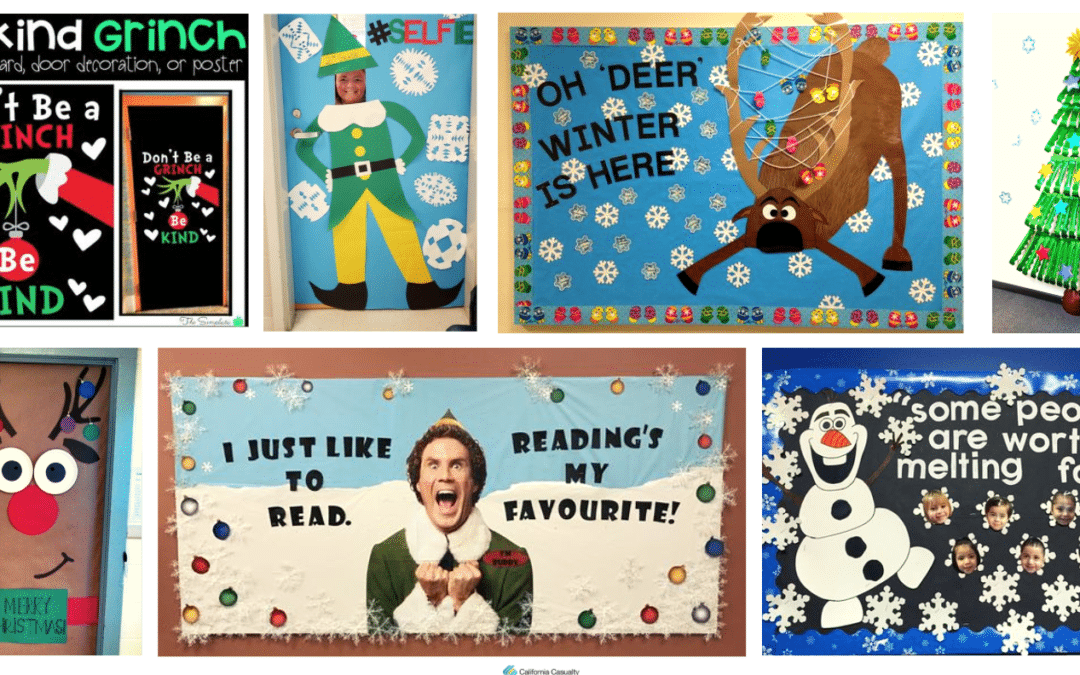
by California Casualty | Educators |
It’s the most wonderful time of the year! The excitement of the looming Winter Break can be felt in every classroom, and what better way to celebrate than with some fun and festive Bulletin Boards? It’s officially to de-stress and have fun creating some winter bulletin boards for your kids and classroom.
We’ve pulled together our favorite ideas for Winter, Christmas, and more below. Check them out! And for all the teachers teaching remotely, you don’t miss out on the fun! Use these ideas for your Zoom backgrounds, or even create (fake) bulletin board on a blank wall at home!
1. School Door…or Gingerbread House?
Go big or go home, right? You could even put kid’s names or pictures on the gumdrops!
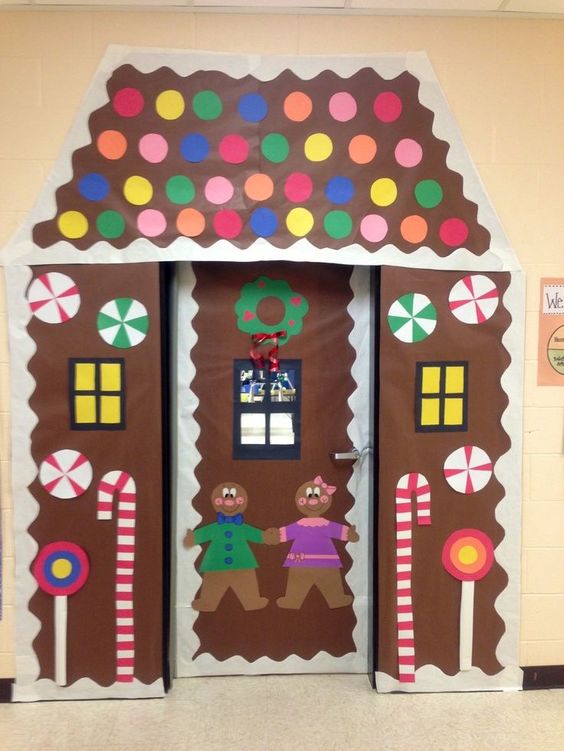
2. Take an #sELFie
Literally, the cutest thing we have ever seen. Take student #sELFies and send them to parents as Christmas cards!
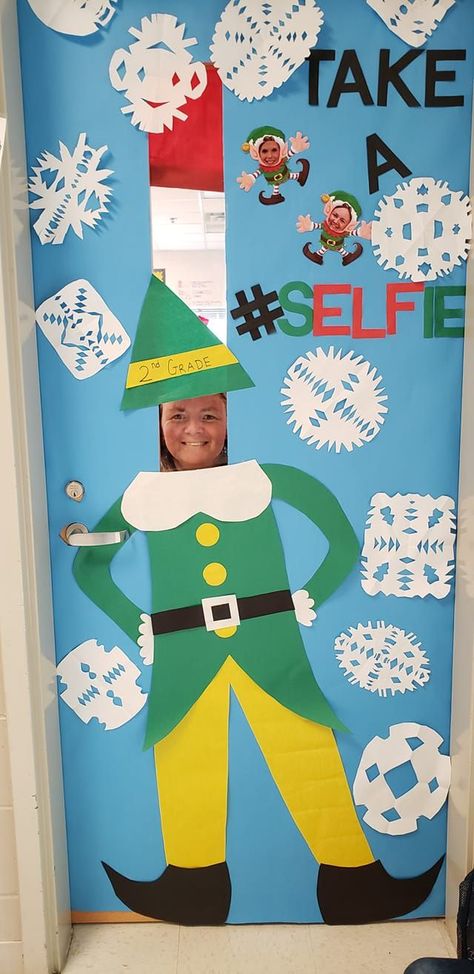
3. A Charlie Brown Christmas
Throw it back to your childhood, with a classic Snoopy bulletin board. You can even add each child’s name or photo on the lights, like they have below.
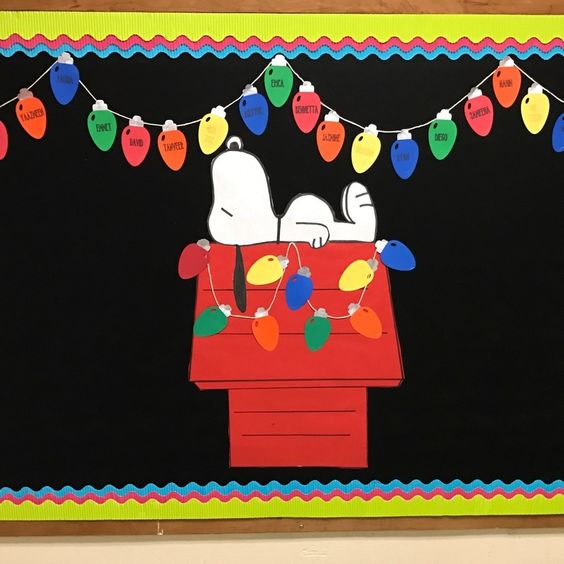
4. A Kindness Christmas Tree
Make a countdown until break and reveal a new kindness quote each day.
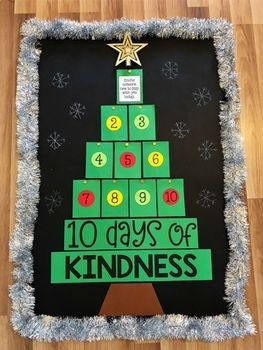
5. Frozen-Themed
Winter isn’t complete without Olaf in your classroom!
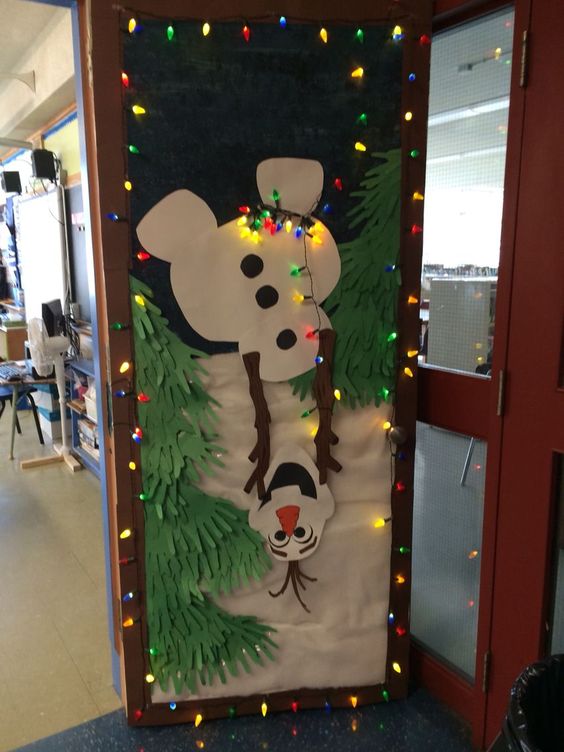
6. Under Elf Surveillance
This elf can be on mask duty in the hallway OR or classroom duty, just put it on your door.
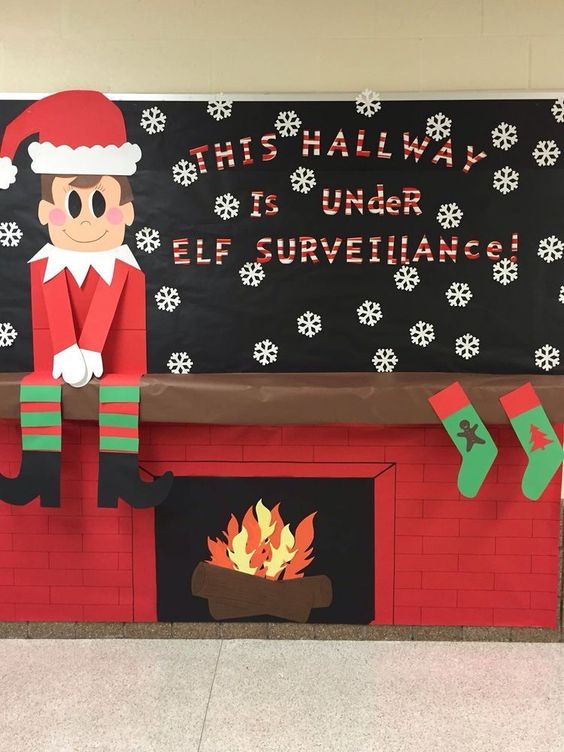
7. ….Or You Could Use a Different Elf
You could use so many different sayings on this Buddy the Elf Bulletin Board.

8. Wall of Joy
We’d be lying if we didn’t tell you this one was our favorite. Put this in the hall and have each child write what brings them joy 🙂 (for sanitary reasons, be sure to have them use their own writing tool)
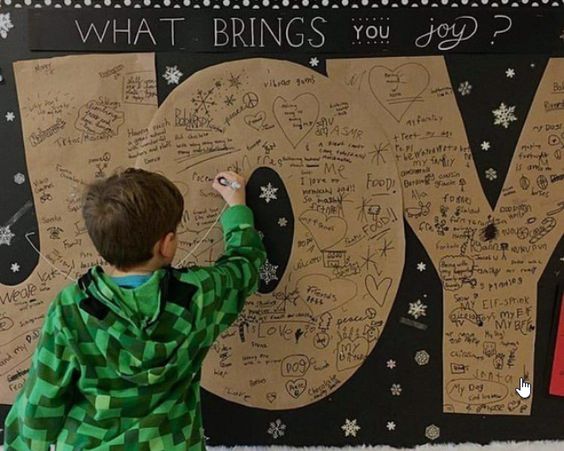
9. Rudolph ft. DIY Christmas Ornaments
Have kids make their own ornaments! Want something a bit more simple? Just showcase the ornaments hanging from the top of the bulletin board instead.
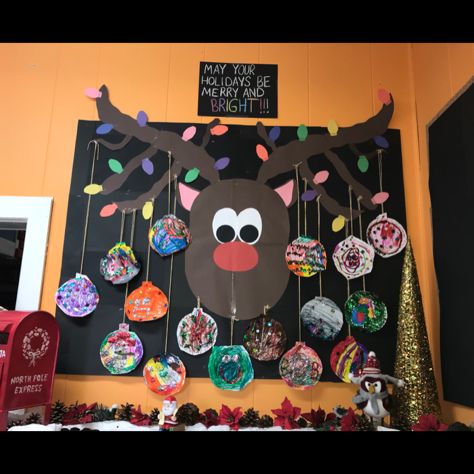
10. Reading Makes You Bright
We love the symbolism! Except in the photo, all of the snowflakes are the same…So, be sure to have your students each make snowflakes to hang on your board!
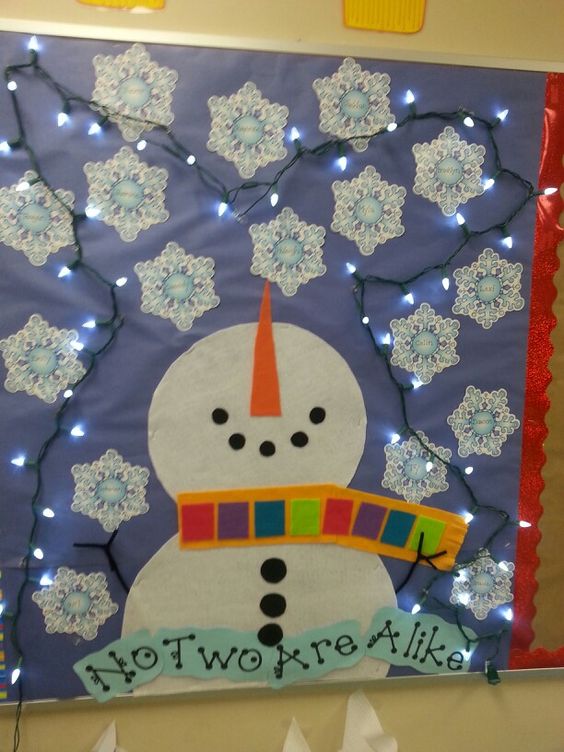
11. Don’t be a GRINCH be Kind
Because who doesn’t love The Grinch?

12. Oh Deer! Christmas is Almost Here
Each child can make their own unique reindeer.
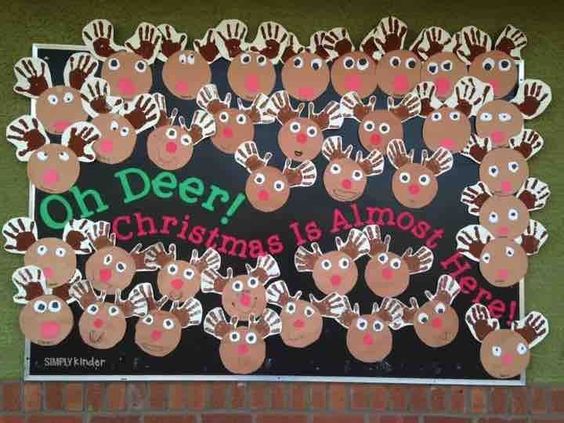
13. Chillin’ With My Snowmies
You could leave it as is, or for a larger board have each student make a snowman or Santa-gnome!
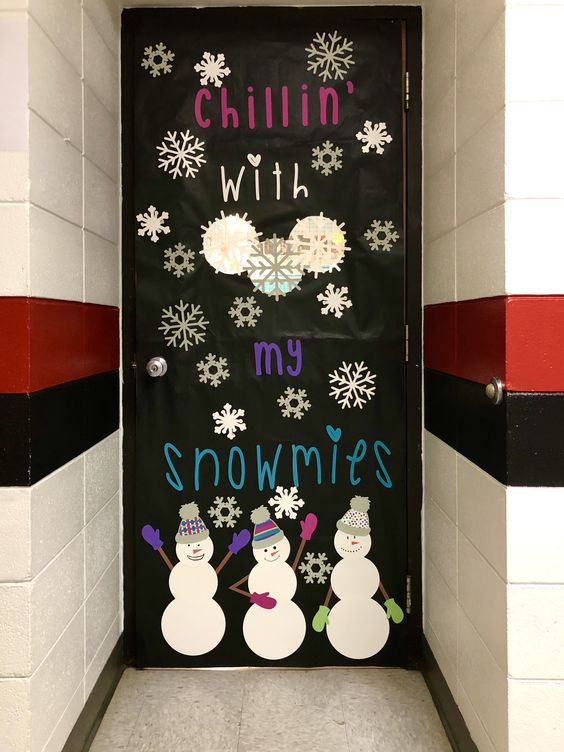
14. If Santa Was Stuck In My Chimney…
You can’t beat a funny holiday writing prompt!
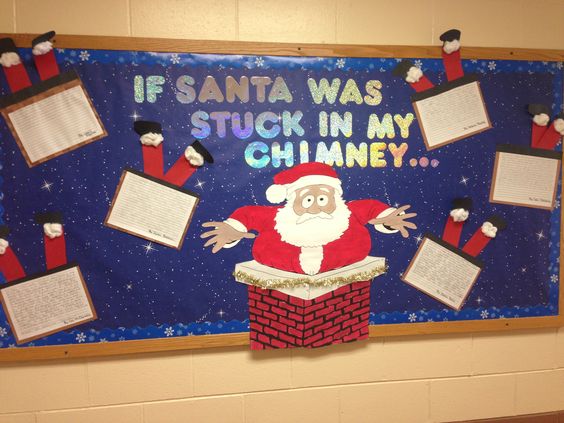
15. A Tree Made of Border
So we know this technically isn’t a bulletin board, but what a cool idea to make a tree out of extra border paper!
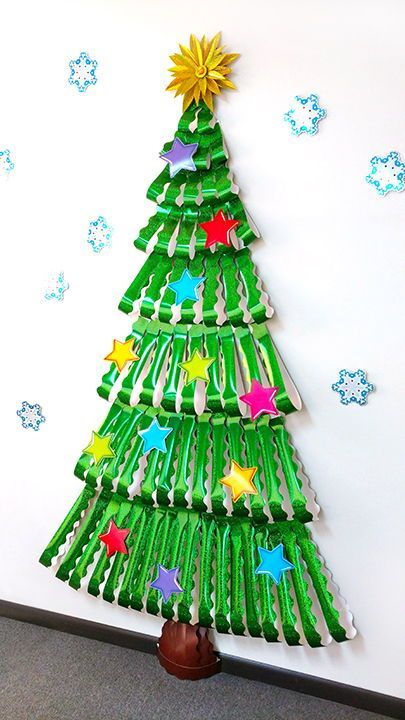
16. Fa-la-la Singing Reindeer
Holiday cuteness overload

17. Learning is a Gift
A classic, that is easy to create and really make your own. Put subjects or children’s names on the presents!
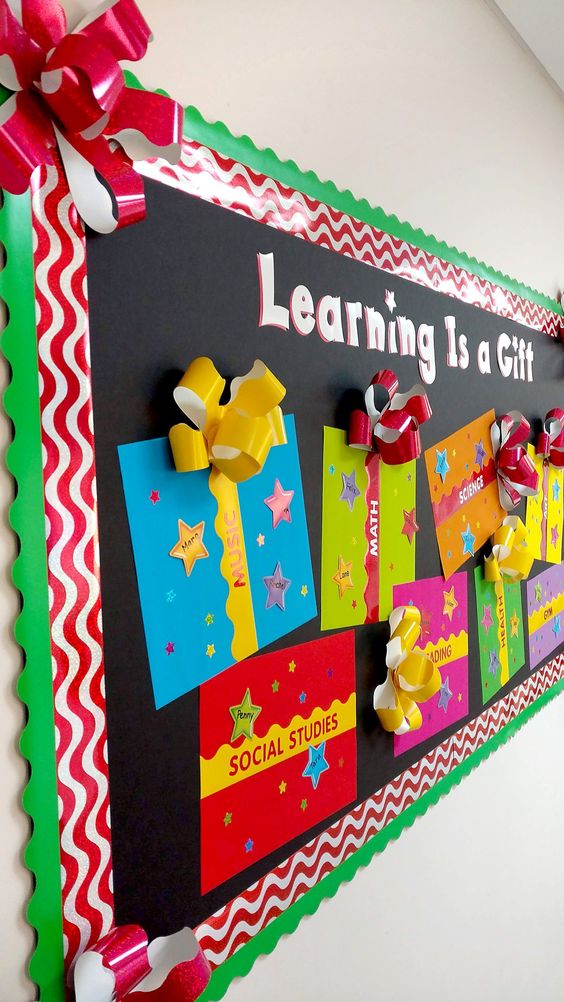
18. Loco for Cocoa
Another easy writing prompt idea, kids can write their perfect hot cocoa recipe and decorate their own mug.
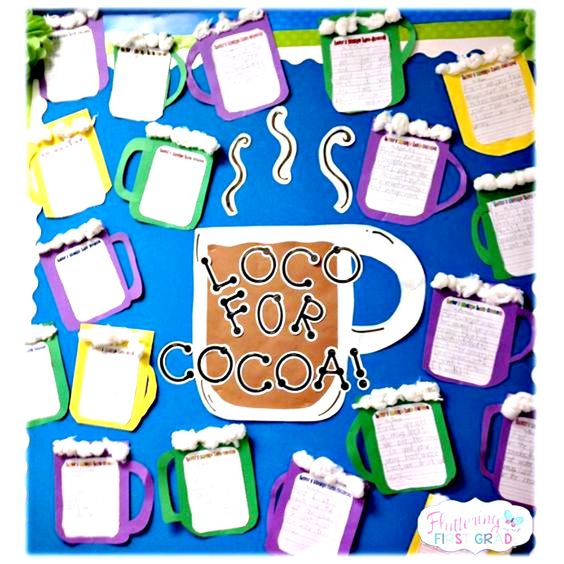
19. Stockings Hung By The Chimney With Care
Keep it nice and cozy this winter with this cute classroom fireplace. Kids can even make their own stockings and hang them up for Santa!
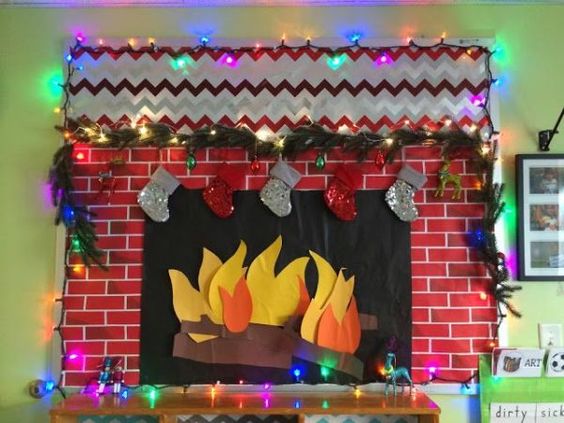
20. Teacher-Elves in a Snow Globe
Don’t be afraid to make a silly bulletin board like this, it’s guaranteed to make your student’s day!
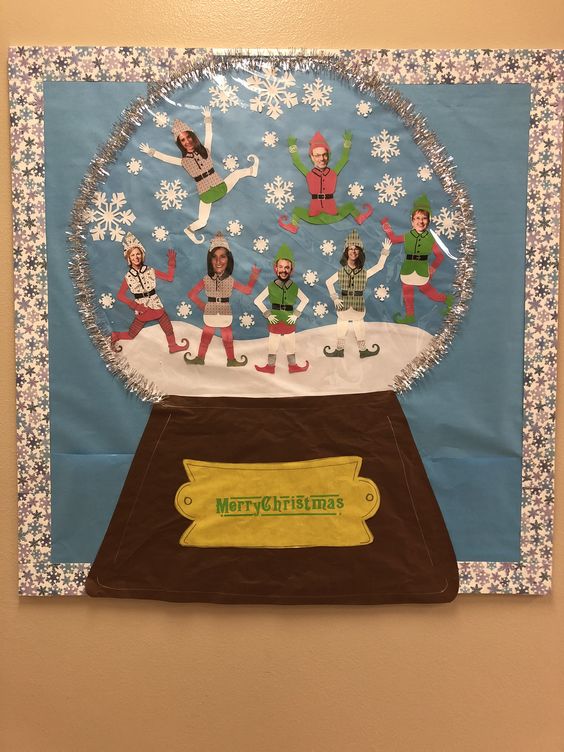
21. Fal la la la llama
Because Christmas doesn’t always have to be able elves and reindeer.

and, last but not least, our honorable mention…
Frosty’s Baby Picture
A true work of art.
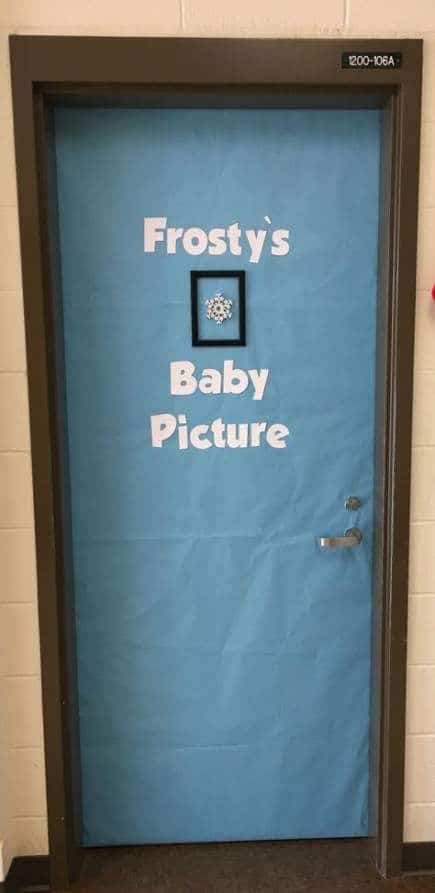
Head over to our Pinterest for more Christmas & Winter Bulletin Board options! Don’t forget to give us a follow at California Casualty to stay up to date on every new idea we discover! Scan our Pincode with your Pinterest camera to follow:

This article is furnished by California Casualty, providing auto and home insurance to educators, law enforcement officers, firefighters, and nurses. California Casualty does not own any of the photos in this post, all are sources by to their original owners. Get a quote at 1.800.800.9410 or www.calcas.com.
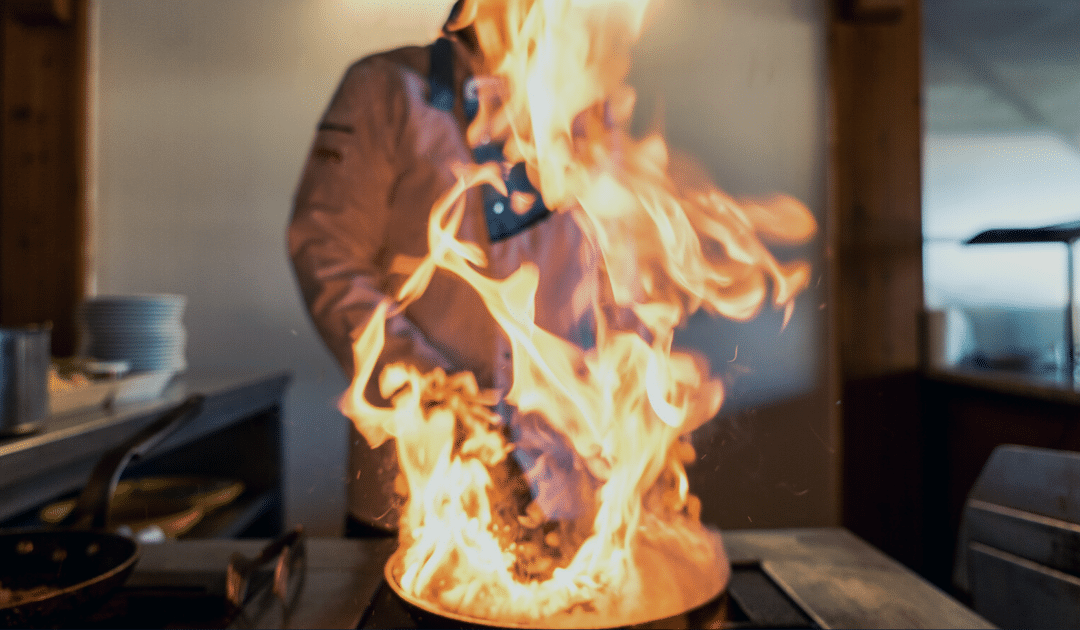
by California Casualty | Homeowners Insurance Info, Safety |
Did you know that cooking fires in residential buildings happen more often on Thanksgiving Day than any other day of the year? Or that peak timing for fires is from 10am – 4pm — right when everyone’s preparing their turkey day feasts?
According to the National Fire Protection Association, unattended cooking is by far the number one contributing factor of cooking fires and fire deaths.
The following tips from NFPA will help you avoid the common pitfalls and serve up a holiday full of delicious dishes, happy memories, and a safe celebration.
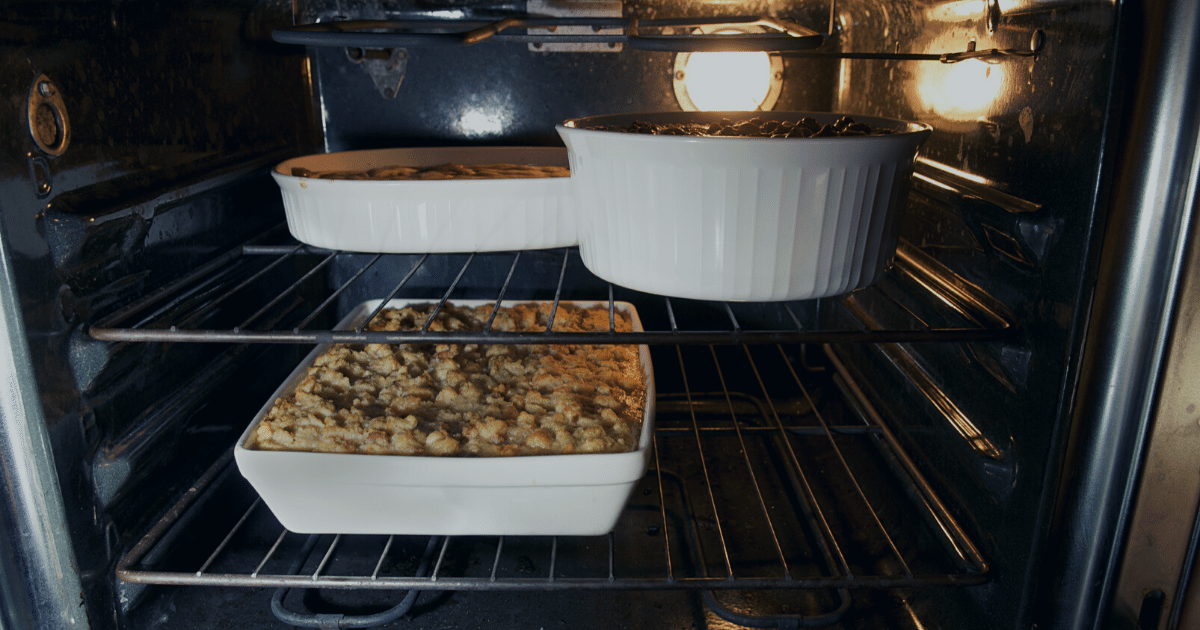
Remember to:
-
- Stay in the kitchen when cooking as much as possible:
-
- If you’re frying, boiling, grilling, or broiling food and need to leave the kitchen for even a short time, turn the stove off until you return.
- If baking, simmering, or roasting, check it regularly, stay in your home, and use a timer to remind you when it’s close to done.
- While cooking turkey, check on it frequently, and do not leave your home.
- Test your smoke alarms a few days before the holiday to make sure they’re working.
- Keep oven mitts, food packaging, towels, and any other flammable materials away from your stovetop.
- Keep the kitchen floor free of tripping hazards.
- Don’t use the stove or stovetop if you’re sleepy or have consumed alcohol.
- Be mindful of children:
- Keep them at least 3 feet away from the stove.
- Make sure knives, electric cords, and matches/lighters are out of reach.
- Ensure they stay away from hot food and liquids.
- Never leave them alone in a room with a lit candle.

Prevent a Fryer Fire
Deep frying turkeys is all the rage — and unfortunately causes plenty of fires and injuries every year. If you plan to fry this year, follow these safety tips from the U.S. Fire Administration:
-
-
- Only use a unit specifically made for frying turkeys — don’t try to adapt cookware you already have.
- Only use the fryer outdoors on a sturdy, level surface that is a safe distance from anything flammable. Remember that fryers can easily tip over, spilling hot oil. Maintain a 3-foot zone free of kids and pets to protect against injuries.
- Make sure your turkey is fully thawed before frying it — a partially frozen bird will cause hot oil to splatter.
- Ensure that you use the correct amount of oil. An overfilled fryer will spill over when the turkey is placed inside.
- Do not leave the fryer unattended. A 15-pound turkey will take about 45 minutes to cook, so prep in advance so that you can stay outside the whole time.
- Use gloves and have extra potholders and supplies nearby. The pot, lid, and handles of the fryer can get very hot.
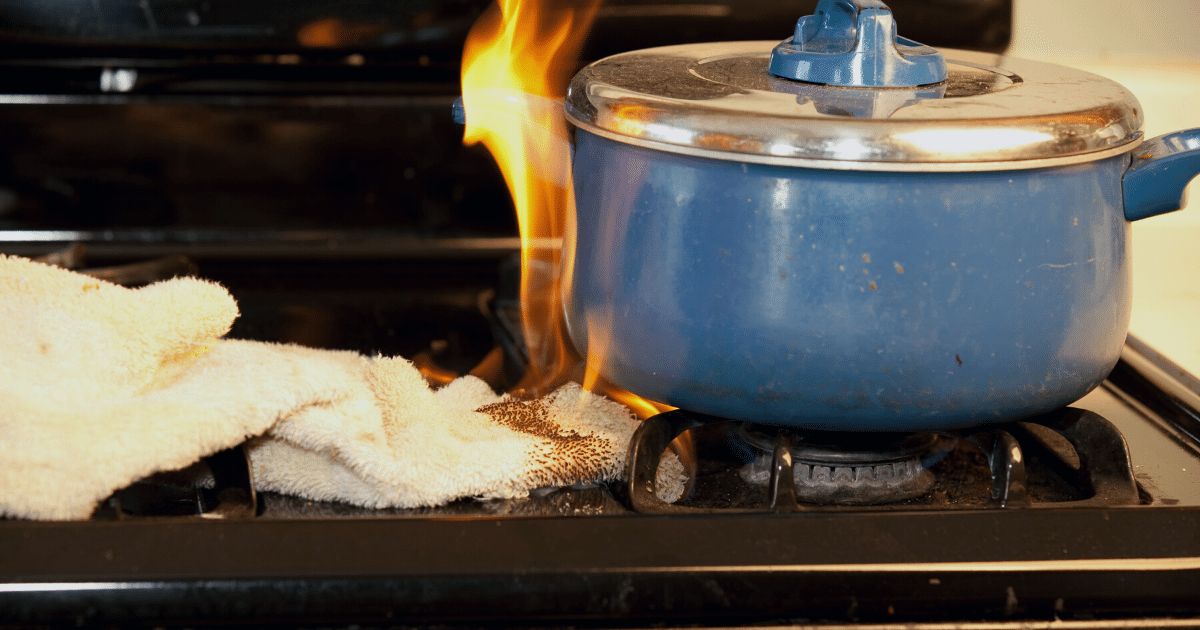
In Case of Emergency
A small grease fire can erupt suddenly — even despite best efforts at prevention. Here are some basic steps from the NFPA if one erupts on your watch.
-
-
- For an oven fire, turn off the heat and keep the door closed.
- If on the stovetop, smother flames by putting a lid or baking sheet over the pan, taking it off the heat, and turning the burner off. Leave the pan covered until completely cooled.
- Do NOT pour water on a grease fire — it will make it worse or even spread the fire. A lid or cooking sheet is best; pouring baking soda or salt on small flames can also help extinguish them.
- When in doubt, get out of the house. Close the door behind you and call 911.
The holidays are busy. Between cooking and hosting time and focus can feel scant. To let you focus on cooking — safe cooking, that is — enlist the whole family to help. Tasks such as shopping, decorating, and cleaning can be delegated. While in the kitchen, make sure someone else is on point for entertaining and taking care of things in the rest of the house. Finally, prepare activities (games, puzzles, books, etc.) ahead of time for children so that they’re occupied and out of the kitchen.
And most important: enjoy that precious time with your family — over a delicious, beautiful meal!
This article is furnished by California Casualty. We specialize in providing auto and home insurance to educators, law enforcement officers, firefighters, and nurses. Get a quote at 1.866.704.8614 or www.calcas.com.
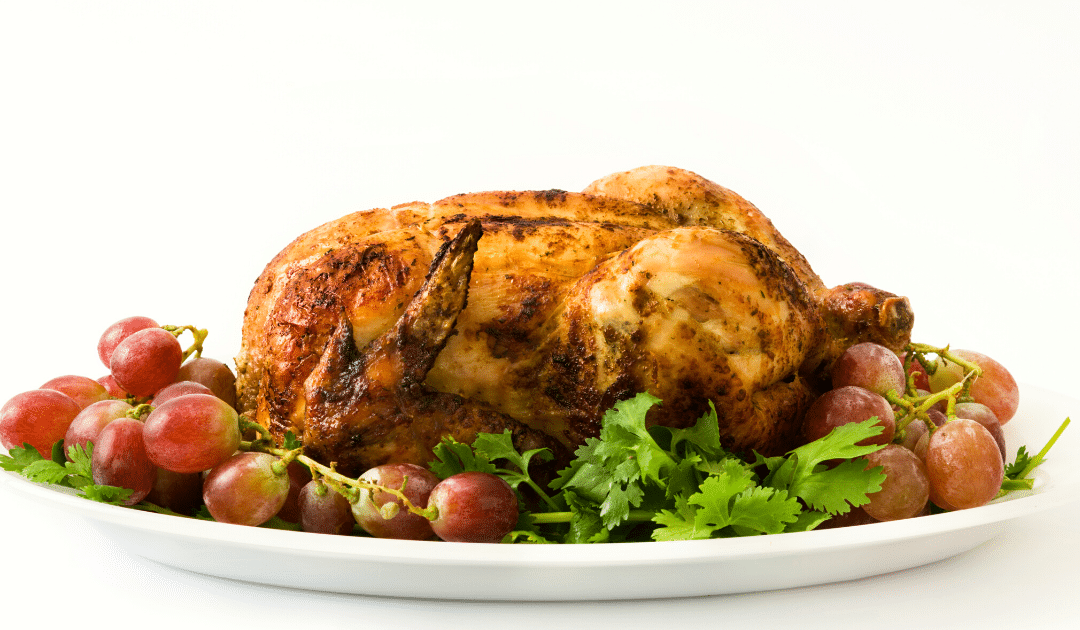
by California Casualty | Safety |
All across America, people are missing their extended families – and now even more so with Thanksgiving and the holidays quickly approaching. What we’ll miss most this November are the warm hugs, embraces, and cheek kisses; passing dishes around the table; and piling on the couch with overstuffed, yet happy, bellies.
Many are skipping large gatherings this year, in favor of smaller dinners with only household guests. If you’re hosting a small family dinner this year, you may be wondering how to balance safety with the traditions that make Thanksgiving so special.
See the tips below for striking that balance and answering some common safety questions.
Can I have a Normal Thanksgiving?
Thanksgiving may look a bit different this year for many different families. States all across the country have enforced strict guidelines limiting gatherings of more than 10 people and encouraging families to cancel their plans. However, millions of people still flocked to the airport this weekend to travel in preparation for the holiday.
So, should your Thanksgiving look normal this year? Yes and no. For some it is best to cancel, for others who don’t want to break tradition, it is best to limit your gathering to just immediate family (those in your household) or at least keep it under 10 people and have a small Thanksgiving. However, that will not change the food, or the laughs, or the memories you will make. Encourage relatives that are staying home and cooking their own meals this year to Facetime or Zoom in, so you can all still enjoy the holiday “together” while staying safe.
How Can I Keep My Small Gathering Safe?
For those who are making the decision to continue on with a small gathering, hosts will be doing more work this year- that’s for sure. But with some planning and attention throughout the evening, you can serve a meal your guests will love and keep everyone safe in the process.
-
- “Small Gathering” Must Mean Small Gathering. Only immediate family or no more than 10 people.
- Lay the Ground Rules. As the host, you’re the one who sets the tone about safety. Remember that having safety measures doesn’t mean your holiday needs to be any less warm or wonderful.
- Plan Ahead. If you are including a few family members outside of your household, send safety expectations ahead of time, to give people time to plan and adjust. Make sure everyone knows and agrees to the rules. Remind them that the precautions are meant to protect them and those they love, and if they would not like to follow them, they can stay home.
- Sanitize Ahead of Time. Disinfect surfaces in bathrooms and common areas. Provide disposable paper towels instead of cloth ones. Put out multiple bottles of hand sanitizer to remind people to use them.
- No Ifs, Ands, or Buts. If anyone in your household becomes sick or is exposed to the virus beforehand, the dinner must be called off – this goes for you as host as well as for guests.
- Social Distancing and Safety from the Get-Go. If you invite family outside of your household, remember to maintain social distance inside of your home and to avoid kissing, touching, and handshakes. Guests should also wear facemasks whenever possible (supply a box of surgical masks).
- Be the Designated Server. To cut down on cross-contamination, hosts should serve all food and drink (and be masked while doing so). If dinner has to be served buffet-style, make sure everyone sanitizes before going through the line.
- Go Compostable. Consider disposable and compostable paper plates, napkins, utensils, and cups to reduce the chances of transmission.
- Dine Outdoors if Possible. By now we know that dining outdoors versus indoors greatly reduces the chances of transmission, so if possible, plan for that.
- If Inside- Space Out. If circumstances necessitate an indoor event, plan your gathering in a large room, spacing tables, and chairs apart. Open windows (have lap blankets available) to bring the fresh air in. Or you can set up multiple tables and have relatives eat in different rooms.
- Mind the Alcohol. We all know alcohol lowers inhibitions and can change behavior. If folks begin to mingle, bunch together, or wander the house, remind them about social distancing. Use markers for wine and cocktail glasses so everyone keeps their own glass. Hosts should pour/serve drinks rather than lots of people handling the bottles.
Should People Be Tested Beforehand?
One of the things that makes the pandemic so frustrating is the difficulty around knowing for sure whether any of us is carrying the coronavirus. Part of that is due to issues around testing: the time lag between test and results, the false negatives, and even the lack of available testing in some places.
If family members coming to your dinner (or children that have been away at school) would like to get tested beforehand- encourage them to. This way you can all have a little piece of mind when sitting down at the dinner table. Even if everyone tests negative, still emphasize masking, handwashing, social distancing, and other proven preventive measures you can take as host.
At the end of the evening, remember to load glasses and any ceramic dishes in the dishwasher on high heat and sanitize all surfaces, doorknobs, and handles.
Should I Feel Bad for Canceling?
And finally, don’t feel bad for canceling or having to uninvite guests that usually come to your Thanksgiving feast. If you have any fears at all, or become overwhelmed with stress/anxiety about the day- don’t be afraid to cancel. This is a very crazy time (to say the least) and family members will likely understand. The health and safety of you and your immediate family should always be your number one priority.
Stay safe and have a happy Thanksgiving.
This article is furnished by California Casualty, providing auto and home insurance to educators, law enforcement officers, firefighters, and nurses. Get a quote at 1.866.704.8614 or www.calcas.com.
by California Casualty | News |
We have amazing employees at California Casualty. The Employee Spotlight is a new series aiming to highlight those talented individuals that make up our successful company culture and community. From human resource recruiters and learning and development trainers to claims adjusters, marketers, customer support specialists, partner relations, sales representatives, and beyond; each week, we’ll highlight a new team member, so you can get to know us better and see how our employees make us who we are as a company.
This edition of the Employee Spotlight will feature Field Marketing Manager, Jackie Jones.
Jackie has been with us for 4 years and works remotely covering territories in Virginia and Maryland for our Partner Relations team.
Let’s get to know Jackie!

What made you want to work as a Field Marketing Manager for California Casualty?
I was stuck at a desk job, I typed in the word “field” to Indeed and CalCas popped up! As soon as I read who we cater to, I wanted in!
What is your favorite part about your job?
My favorite part about my job is the ability to make connections and long-lasting friendships with those who I work with in the field
I love the freedom of working in the field! Being stuck in the house (COVID-19) definitely created its challenges, but it sparked a whole new mindset and I feel as if I have thrived from it.
What have you learned in your position at California Casualty?
The most useful information…I am not entirely sure. I know that I was horrible at and dreaded making small talk. I’d just never learned to be comfortable with it throughout my life. This job has taught me how to effortlessly make small talk, and then turn it into a great opportunity!
What are your favorite activities to do outside of the office?
My favorite activities used to be in-person NEO’s, it was such a rush! Now, my favorite activity is social media mass marketing! Seeing how many people have actually looked at the post or took the time to like/comment on it is a rush!
Anything else you would like the audience to know about you?
Let’s see…
I met my fiancé on Bumble almost 4 years ago. (swiping right works! Haha!)
I am a rescue dog mom of 3. Luna – lab border collie mix, Vince – pit plott house mix, and Archie – whippet Chihuahua mix. I have 4 beta fish, Rick and Morty (from the TV show), and Bucky and Zippy (for the Buckeyes and Akron). I also have an angelfish and a catfish. My family calls me Dr.Dolittle!
I am a First Team All-American lacrosse player.
I am the head coach of a high school Varsity Girl’s lacrosse team
I have become a Cricut fanatic, making personalized cups! I also learned how to etch glass!
I am a plant mom! I have over 30 plants in my house!
If you want to learn more about Jackie or are interested in a career at California Casualty, connect with her on LinkedIn! Or visit our careers page at https://www.calcas.com/careers
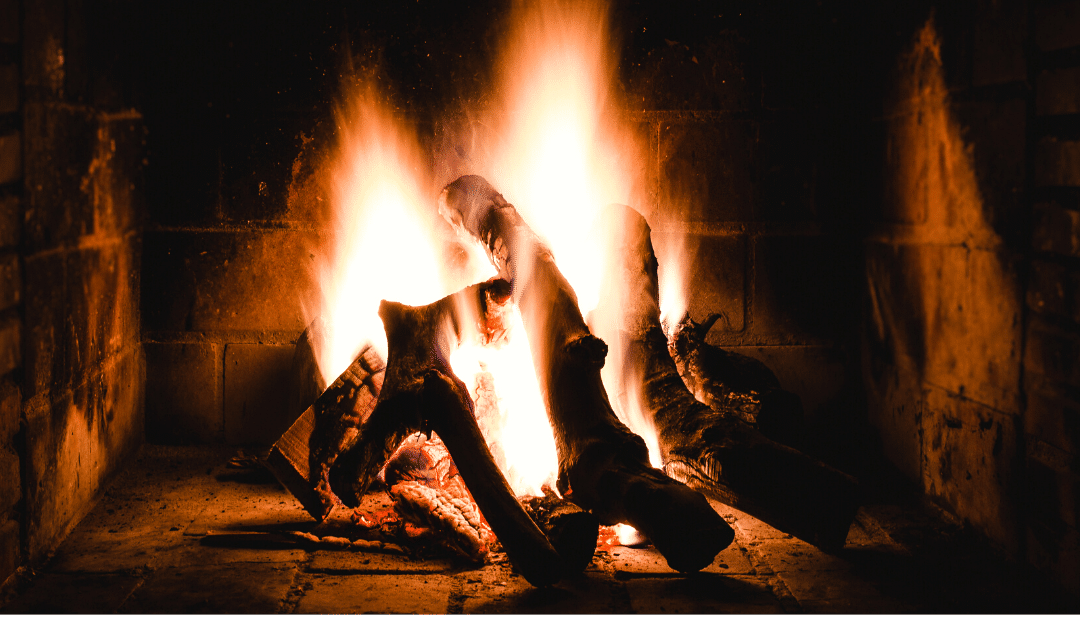
by California Casualty | Good to Know, Homeowners Insurance Info |
Reducing your home energy usage is good for several reasons. First and foremost, it keeps money in your pocket. But it also lightens the load on local power grids and the environment — a win-win all around.
Try some or all of the 12 steps below to save on your energy bill while staying cozy and comfortable in your home. They’re easier than you think!
1.Let the Light Shine In
Use the sun’s heat (bonus: it’s free!) to your advantage! Open curtains and blinds on your south-facing windows during the day to let the heat in and then close them at sunset to keep it in.
2. Leak-Proof Your Home
Inspect your home for leaks (get tips from energy.gov on detecting air leaks here). Often invisible, leaks can wreak havoc on your energy bill. Use weather stripping and caulking to seal leaks and keep warm air inside. While you’re at it, insulate your ducts, which can be a significant source of heat loss. For windows that you rarely use during winter, get plastic window kits to further leak-proof.
3. Bump the Temp Down
Just by setting your thermostat a few degrees lower, you can immediately begin saving. Consider installing a programmable thermostat for even more time- and energy-efficiency.
4. Pay Attention to Your Water Heater
Water heaters account for about 17 percent of a home’s energy use – adding up to about $400-600 per year for the average household. Bring that down by:
-
- using less hot water
- setting your water heater’s thermostat to 120 degrees F.
- buying an energy star model when it comes time to replace it
- fixing leaks
- washing clothes in cold water
- installing low-flow showerheads and faucets
5. Check the Fireplace
When not burning a fire, keep the damper closed. Consider installing tempered glass doors and an air exchange system that blows warm air back into the room. Check the seal on the flue damper and make sure it’s tightly sealed. Finally, add caulking around the hearth. If you never use your fireplace, plug and seal the flue.
6. Maintain Your Heating System
Have a professional check and tune-up your heat pump or furnace once a year. This could lead to big savings. Make sure they also replace any clogged filters, which can make your furnace work harder, thereby raising energy costs (you can also check and replace filters yourself).
7. Close Unused Vents
In rooms that are rarely used, fully or partially close the vents to redirect heat to other rooms.
8. Use Ceiling Fans
Everyone knows heat rises, which means the air you’ve paid to heat rises and collects at the tops of rooms. This can be especially costly in homes that have high ceilings. Use your ceiling fans to push warm air downward – just make sure they’re set to run in a clockwise direction.
9. Check Your Insulation
If your attic doesn’t have at least 11 inches of insulation, you’ll most likely lose heat through the upper level of your home.
10. Recycle That Hot Air
After cooking, leave the oven door open a crack to let the heat help warm the house. Bonus? You get to savor the delicious smell of those cookies, baked goods, or dinner a little longer.
11. Space Heaters
Portable heaters are a good cost-saving option if you and your family are hanging out in one room for any length of time, or if you’re the only one home and are stationary (like working in a home office). But remember to use caution whenever using space heaters – according to the Consumer Product Safety Commission, these heaters cause more than 25,000 residential fires per year. Follow the heater instructions carefully and always unplug them when not in use.
12. Bundle Up
Sweaters, socks, and cozy blankets really do make a difference.
By making a few tweaks in your home and modifying some behaviors, you’ll begin to see cost and energy savings in no time.
And as we transition from winter to spring and summer, check out our companion piece on lowering your cooling costs.
This article is furnished by California Casualty, providing auto and home insurance to educators, law enforcement officers, firefighters, and nurses. Get a quote at 1.866.704.8614 or www.calcas.com.































